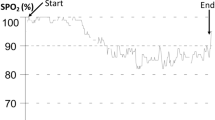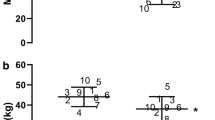Abstract
This study investigated the relationships between resting whole blood viscosity (WBV), haemoglobin concentration (HGB), haematocrit (HCT), and performance in 25 highly-trained national squad rowers (11 women and 14 men). The WBV and HGB were measured at rest prior to a 2500 m simulated race on a Concept rowing ergometer when performance (P) was measured by average velocity. A group of 12 rowers were measured on just one occasion, another 11 were measured twice with an intervening 5 weeks of continued training and 2 were measured three times, the third test after another 4 weeks. Regression analyses making simultaneous use of both intra- and interindividual data indicated a significant inverse relationship between P and WBV (at both high and low shear rates), a relationship which was strengthened after statistically controlling for the effects of HGB, this effect being slightly more significant than HCT. A significant positive regression also emerged between P and HGB, but only after statistically controlling for the influence of WBV at high shear rate. Overall, stronger relationships were demonstrated in the male rowers compared with the female. These data, in the light of previous evidence that fitter people tend to have lower WBV, would indicate that blood rheology unrelated to HGB (or HCT) is related to performance in relatively homogeneous and already highly-trained athletes.
Similar content being viewed by others
References
Brotherhood J, Brozovic B, Pugh L (1975) Haematological status of middle- and long-distance runners. Clin Sci Mol Med 48:139–145
Brun J, Sekkat M, Lagoueyte C, Fedou C, Orsetti A (1989) Relationships between fitness and blood viscosity in untrained normal short children. Clin Hemorheol 9:953–963
Buick F, Gledhill N, Froese A, Spriet L, Meyers E (1980) Effect of induced erythrocythemia on aerobic work capacity. J Appl Physiol 48:636–642
Charm S, Paz H, Kurland G (1979) Reduced plasma viscosity among joggers compared with non-joggers. Biorheology 16:185–189
Dacie J, Lewis S (1984) Practical Haematology, 6th edn. Churchill Livingstone, New York, pp 34–35
De Scalzi M, Cinelli P, de Leonardis V, Becucci A, Mariani R, Fattirolli F, Ciapini A (1987) Response of some haemocoagulatory and haemorheological variables to maximal exercise in sedentary and active subjects. J Int Med Res 15:361–367
Dintenfass L, Lake B (1976) Exercise fitness, cardiac work and blood viscosity factors in patients and normals. Eur Surg Res 8:174–184
Dintenfass L, Lake B (1977) Blood viscosity factors in evaluation of submaximal work output and cardiac activity in men. Angiology 28:788–798
Ekblom B, Berglund B (1991) Effect of erythropoietin administration on maximal aerobic power. Scand J Med Sci Sports 1:88–93
Ernst E, Matrai A, Aschenbrenner E, Will V, Schmidlechner C (1985a) Relationship between fitness and blood fluidity. Clin Hemorheol 5:507–510
Ernst E, Schmid M, Matrai A (1985b) Intraindividual changes of haemorheological and other variables by regular exercise. J Sports Cardiol 2:50–54
Ernst E, Matrai A, Aschenbrenner E (1985c) Blood rheology in athletes. J Sports Med 25:207–210
Ernst E, Weihmayr T, Schmid M, Baumann M, Matrai A (1986) Cardiovascular risk factors and hemorheology: physical fitness, stress and obesity. Atherosclerosis 59:263–269
Fendler K, Matrai A (1980) Changes of blood viscosity in adolescent swimmers and adult weight-lifters. Hung Rev Sports Med 21:199–203
Galea G, Davidson R (1985) Hemorheology of marathon running. Int J Sports Med 6:136–138
Genstat 5 Committee (1987) Genstat 5 reference manual. Clarendon Press, Oxford
Gledhill N (1985) The influence of altered blood volume and oxygen transport capacity on aerobic performance. Exerc Sport Sci Rev 13:75–93
Hobbs J, Oats J, Palmer A, Long P, Mitchell G, Lou A, Melver M (1982) Whole blood viscosity in pre-eclampsia. Am J Obstet Gynaecol 142:288–292
Kovacic J, Telford R (1992) Review: blood viscosity in athletes. Excel 8:73–84
Lange H (1946) The normal plasma protein values and their relative variations. Acta Med Scand [Suppl] 176:1–202
Letcher R, Pickering T, Chien S, Laragh J (1981) Effects of exercise on plasma viscosity in athletes and sedentary normal subjects. Clin Cardiol 4:172–179
Lowe G (1988) Nature and clinical importance of blood rheology. In: Lowe G (ed) Clinical blood rheology, vol 1. CRC Press, Baton Rouge, Fla, pp 1–44
Lowe G, Barbenel J (1988) Plasma and blood viscosity. In: Lowe G (ed) Clinical blood rheology, vol 1. CRC Press, Baton Rouge, Fla, pp 11–44
Martin D, Ferguson E, Wigutoff S, Gawne T, Schoomaker E (1985) Blood viscosity responses to maximal exercise in endurance-trained and sedentary female subjects. J Appl Physiol 59:348–353.
Martins-e-Silva J (1988) Blood rheological adaptation to physical exercise. Rev Port Hemorreol 2:63–67
Oscai L, Williams B, Hertig B (1968) Effect of exercise on blood volume. J Appl Physiol 24:622–624
Robinson G (1991) That BLUP is a good thing: estimation of random effects. Stat Sci 6:15–51
Romatar J (1990) Cyclists deaths linked to erythropoietin? Phys Sports Med 18:48–50
Telford R, Cunningham R (1991) Sex, sport and body size dependency of hematology in highly trained athletes. Med Sci Sport Ex 23:788–794
Telford R, Egerton W, Hahn G, Pang P (1988) Skinfold measures and weight controls in elite athletes. Excel 5:21–26
Author information
Authors and Affiliations
Rights and permissions
About this article
Cite this article
Telford, R.D., Kovacic, J.C., Skinner, S.L. et al. Resting whole blood viscosity of elite rowers is related to performance. Europ. J. Appl. Physiol. 68, 470–476 (1994). https://doi.org/10.1007/BF00599515
Accepted:
Issue Date:
DOI: https://doi.org/10.1007/BF00599515




